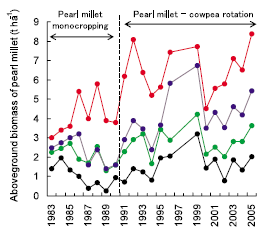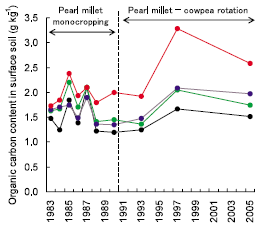Sustainable improvement of soil fertility and pearl millet production by returning crop residues, application of chemical fertilizers and rotation with cowpea in the sandy soil of the Sahel, West Africa
Description
The poor fertility of sandy soil in the Sahel, West Africa, is the principal constraint on crop production, and leads to frequent food shortages. Many trials have been carried out, such as manure application to improve crop production, but the experimental periods of only a few years were too short to observe any sustained effect. A longterm experiment on the cultivation of pearl millet, a staple food in West Africa, has been ongoing at ICRISAT Sahelian Center in Niger since 1983 to evaluate the longterm effects of returning pearl millet residue to the soil and chemical fertilizer application (30-30-0 kg N-P2O5-K2O ha-1) on crop production and soil fertility; in addition, rotation with cowpea has been carried out since 1991. The panicles of pearl millet and the aboveground parts of the cowpea are harvested. We analyzed the pearl millet production data and the soil organic carbon data over 23 years.
Total biomass production of pearl millet increased to 1-3 t ha-1 as a result of either residue returning or fertilizer application, and increased to 3-6 t ha-1 by combining residue returning and fertilizer application, compared with 0.5-2.0 t ha-1 with no input of residue plus fertilizer treatment (Fig. 1). Organic carbon in surface soil increased to 1-2 g kg-1 as a result of the combined treatment, but did not increase significantly as a result of the single treatments (residue returning or fertilizer application) compared with 1.2-1.8 g kg-1 under the no input treatment (Fig. 2).
Pearl millet production under rotation with cowpea was higher, at 0.7-2.4 t ha-1, than under pearl millet monocropping with the single treatments of residue returning or fertilizer application or in the combined treatment, but was not significantly different from the no-input treatment (Fig. 1). Organic carbon in surface soil under rotation with cowpea was 0.6 g kg-1 higher than under monocropping with the combined treatment, but it did not differ significantly from the single treatments or the no-input treatment (Fig. 2).
Pearl millet production shows a significant positive relationship with organic carbon in surface soil (r2 = 0.32, P < 0.01), suggesting that increased soil organic carbon is essential to yield improvement. Returning of crop residue was an effective treatment to increase soil organic matter. Chemical fertilizer application increased biomass production, and the underground parts contributed to increased soil organic matter, which led in turn to improved water retention, nutrient levels, and biological activity, together contributing to improved crop yields.
The single treatments of residue returning or fertilizer application marginally improved soil organic matter, leading to slightly increased pearl millet production. Combining residue returning and fertilizer application improved soil organic carbon to a much greater degree, resulting in high yields and demonstrating the potential to contribute to solving food shortages in West Africa.
Crop residue returning and rotation with cowpea is acceptable for small farmers who have limited funds, but chemical fertilizer application is conducted by the few rich farmers. Pearl millet residue is used as animal feed, so to promote residue returning, increasing the production of an alternative animal feed supply, e.g., by increasing cowpea production, is needed.
Figure, table
-
Fig. 1. Aboveground biomass of pearl millet after pearl millet residue returning and chemical fertilizer application.
Treatments: no input (●), residue returning (●), fertilizer application (●), combination of residue returning and fertilizer application (●). -
Fig. 2. Organic carbon content in surface soil treated by pearl millet residue returning and application of chemical fertilizer.
Legends: See Fig. 1.
- Affiliation
-
Japan International Research Center for Agricultural Sciences Crop Production and Environment Division
- Classification
-
Technical A
- Term of research
-
FY2004, FY2005(FY2003~2005, FY2006~2010)
- Responsible researcher
-
KAMIDOHZONO Akira ( Crop Production and Environment Division )
MATSUMOTO Naruo ( Crop Production and Environment Division )
HAYASHI Keiichi ( Crop Production and Environment Division )
MATSUNAGA Ryoichi ( Crop Production and Environment Division )
TOBITA Satoshi ( Crop Production and Environment Division )
SHINJO Hitoshi ( Kyoto University )
ORCID ID0000-0002-7244-9558KAKEN Researcher No.: 70359826BATIONO Andre ( International Center for Tropical Agriculture )
- ほか
- Publication, etc.
-
KAMIDOHZONO, A. et al. (2006) Japanese Journal of Tropical Agriculture. 50 (Suppl 1) 91-92.
Akira Kamidohzono, Keiichi Hayashi, Naruo Matsumoto, Ryoichi Matsunaga, Satoshi Tobita, Hitoshi Shinjo, Andre Bationo (2007):Effect of long term crop residue amendment on soil carbon and nitrogen on Psammentic Paleustalfs in the Sahel Zone, Niger. Proceedings for the 4th International conference of African Soil Science Society, 7-13 January, 2007, Accra, Ghana.
- Japanese PDF
-
2006_seikajouhou_A4_ja_Part9.pdf557.04 KB


